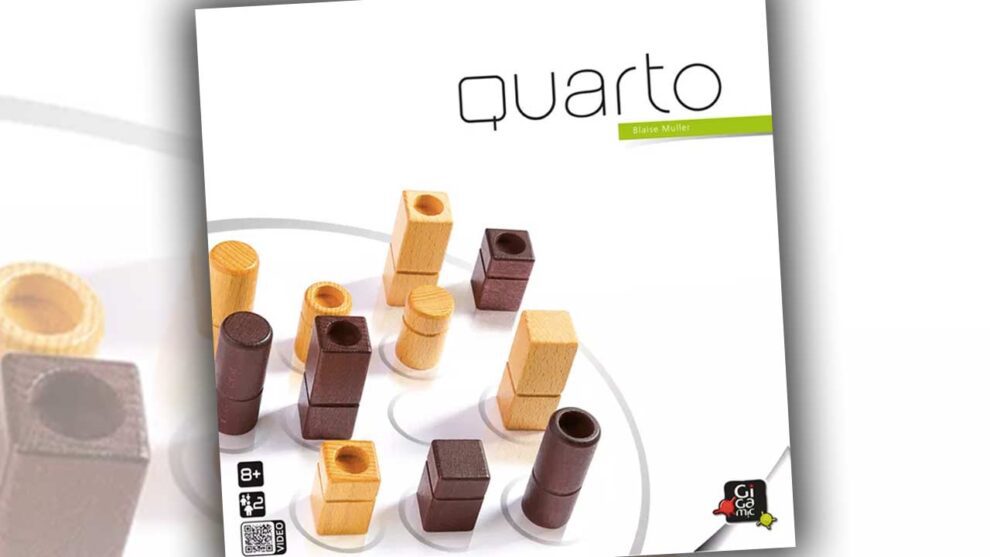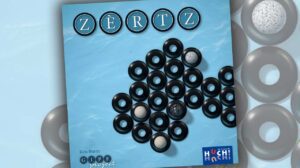Quarto was the 1992 Golden Ace Winner for Game of the Year in France, a 1993 Spiel des Jahres Recommendation, and a Mensa Select winner for 1993. Not too shabby for a 16-piece game played on a 4×4 grid, eh?
Quarto consists of a board with a four-by-four grid with circles at each of the 16 intersections to indicate where pieces are to be placed, along with 16 wooden playing pieces. These pieces are divided into two sets of eight, with one set being lighter in color while the others are darker. As well, eight of the pieces are tall, while eight are short; eight are square, while eight are round; eight are solid, while eight have hollow sections at the top. This means each piece can be sub-divided into four different categories: color, height, shape, and solidity.
The goal in Quarto is to create a four-in-a-row of with any of these four categories—or to be the first player to notice a four-in-a-row. (This can happen.) The four-in-a-row may either line up across the board or diagonally.
The first curve Quarto throws your way is that neither player ‘owns’ any of the four characteristics. Either player may choose to have any of the pieces placed on the board—or win based on any of the characteristics.

The second is brilliant: your opponent chooses the piece you will place on the board, while you select the piece they will place on the board.
By choosing the piece for your opponent to play, your control over the board is somewhat reversed from the way many n-in-a-row games play out. You can, for instance, force a certain token characteristic onto the board, but not where the piece is placed. You can hand your opponent a piece that, if placed on the right spot, could give you an advantage. However, that same piece could be used by your opponent to their advantage.
Similarly, by not being able to choose your own piece to put into play you will rarely be given a piece that works to your benefit. You’ll have to regard both the piece (and all four of its characteristics) and the board to find the best place to place it.
After only a few turns, the decision as to where to place a piece will shifts to being slightly more defensive than offensive. With only 16 points on the board to play the 16 pieces, the board quickly fills up. And, as open spaces become fewer, the variety of shared characteristics of the pieces surrounding those open spaces narrow your choices. If you cannot create a Quarto on this move, you certainly don’t want to leave the board with a possible win for your opponent.
This, then, can make choosing the piece to hand your opponent as complicated as where to play the piece you’ve been handed.
Quarto is a game I love introducing to new players. The game is quick and easy to explain and the choosing-which-piece-your-opponent-will-play mechanic seems novel. After the first, random pieces are chosen and placed on the board, a look of wait a minute… will cross over the new player’s face as the complexity of the game begins to settle in on them.
The first game typically ends with a nod of newfound appreciation for Quarto—and a request to play again right away.
The official rules come with special Variation for Advanced Players. This rule adds an additional winning condition: the first player to create a two-by-two square of four pieces with shared characteristics wins the game. Having played with this rule I can attest that it makes a challenging game even more formidable.












Wow! I have seen this game a few times and have passed it by as a simplistic waste of my time.
Your review, your explanation of this game, jams a nail through my assessment and informs me of just how wrong I have been. I need to check this out more closely and, perhaps, pick up a copy.
This is the kind of game I can see myself enjoying as my wife wins yet another round.
Thanks so much for this review.
It really does look very simplistic from the box cover. However, Gigamic publishes some very good abstracts, this one included.
The fact that no one ‘owns’ any of the shapes or colors makes it interesting. That you hand your opponent the next piece they will play is even more interesting.
(I’ve read where someone plays Hive with “the Quarto rule”, meaning the piece that you can add to the board is determined by your opponent. I’m not sure it would work so well there, but I love that people are adapting this mechanic to other games.)
Also, check your local thrift stores. I found one of my two sets there. : )